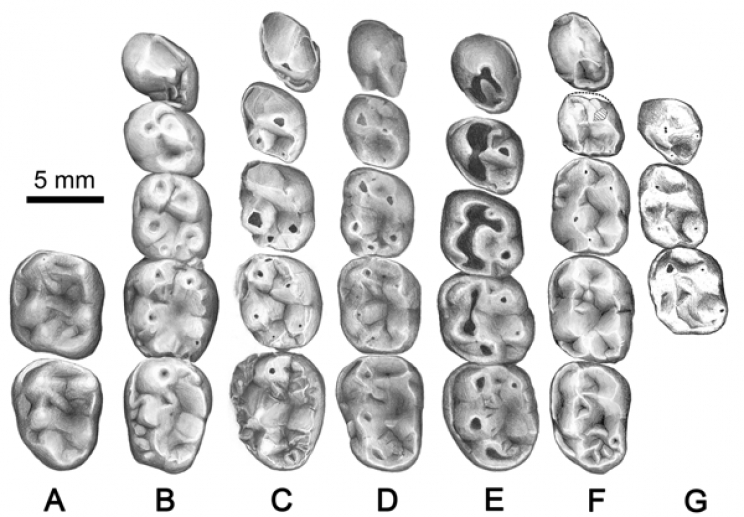
Microwear on the surface of teeth of Pliopithecus canmatensis and Barberapithecus huerzeleri. ICP.
ICP researchers publish this week in the American Journal of Physical Anthropology a revision of the diet of pliopithecids, an extinct group of primates originated in Africa and spread through Europe during Miocene. Studying food marks on teeth of different species, researchers conclude that all pliopithecids fed on fruits, including hard fruits like nuts or unripe fruit.
Pliopithecids are a primitive group of catarrhines (also known as apes of the Old World), which apparently originated before the divergence between the monkeys of the Old World (cercopitecoids) and the group of the anthropomorphs and humans (hominoids). As other catarrhines, they show only two premolars but also a particular dental morphology, with some crests of the enamel that constitute the so-called "pliopithecine triangle" in the lower molars.
European pliopithecids are classified in two groups according to their dental morphology. Crouzeliines show sharper crests, more compressed cusps, larger valleys and relatively narrower and more elongated molars than pliopithecines. These differences were traditionally attributed to diet, which is believed to be mainly based on leaves in the case of crouzeliines. Subsequent analyses of microwear and shearing crests of these teeth determined that all pliopthecids fed on soft fruits except for the crouzeliine Barberapithecus, which would have fed almost exclusively on leaves.

Lower dentition of different species of european pliopithecines and crouzeliines. Marta Palmero. ICP.
This week, a group of researchers from the Institut Català de Paleontologia Miquel Crusafont (ICP) headed by Daniel DeMiguel, published an article in the American Journal of Physical Anthropology suggesting that all pliopithecids (even Barberapithecus) fed on fruits, including in their diet some hard fruits like nuts or unripe fruit. Researchers have come to this conclusion from the analysis of microwear on teeth of Barberapithecus canmatensis and Pliopithecus huerzeleri. These species were described for the first time in Catalonia in 2010 and 2011, respectively.
Although both groups of pliopithecids (pliopithecines and crouzeliines) had a fruit-based diet, the study also concludes that the tendency to feed on hard fruits was apparently more marked in some pliopithecines. Data from extinct species were compared with those of apes, as orangutans, gorillas or chimpanzees of which the diet is known, showing that orangutan diet would be the most similar to that of the studied pliopithecids. Unlike chimpanzees, which feed on leaves when ripe fruit is not available, orangutans prefer to feed on nuts or unripe fruits and, therefore, harder.

Extint pliopithecids would have a similar diet to extant orangutans. http://www.fotopedia.com/items/flickr-2345307590
The study of dental microwear has proven to be a powerful tool to study the diet of extinct species. Abrasions on the enamel, such as scratches or small excavations, are a somehow a record of what a given individual ate during his lifetime. Every type of food leaves a characteristic trace that can be observed and described through electron microscopy.
Pliopithecids are an exclusively Eurasian group, although it was originated from African ancestors that have not been determined yet. In fact, pliopithecus were the first catarrhini to disperse from Africa to Eurasia during the Miocene, about 16 or 17 million of years ago, where they experienced an evolutionary radiation within a continent empty of other apes until then.










